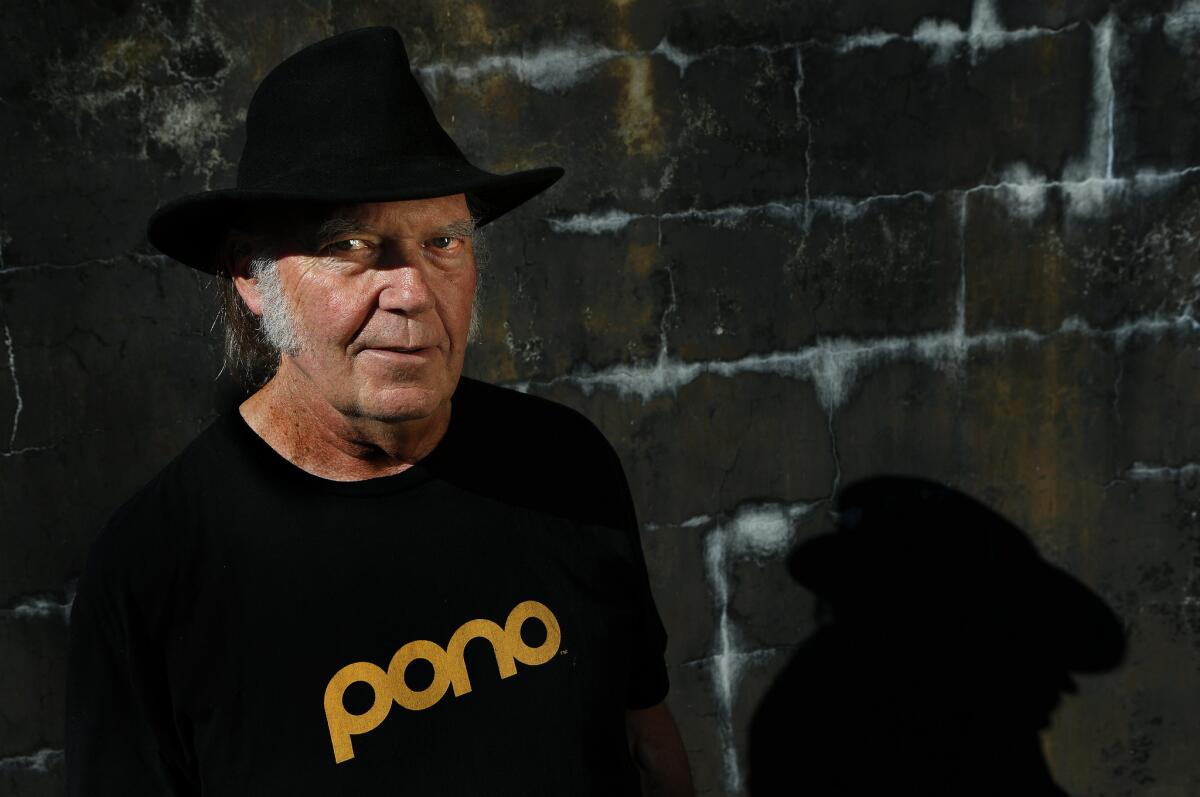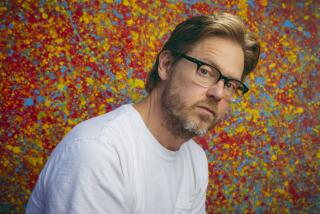Neil Young is out to reinvent the live album on ‘Earth’

Neil Young’s latest work, “Earth,” just might be one of the most unusual projects of a long and varied career. He created some of the wildest music films ever, mashed up electronic music with crunching hard rock and now he’s toying with the live album format.
While drawn from concerts Young has played over the last three years backed by the Promise of the Real, the young band that includes Willie Nelson’s sons Lukas and Micah Nelson, the artist wasn’t necessarily on the hunt for the best live takes of the songs. He was out to manipulate them.
First, he added background vocals from a group of studio singers recorded separately. Then it got weirder.
Young decided to weave in other overdubbed sounds and effects such as the cries of different animals. Why? “I’ve always heard animal sounds in the crowds at shows,” he said during a recent interview at his manager’s home in Topanga Canyon.
Other noises creep in: There are car and truck horns, sounds of ocean waves, and rushing water from brooks and rivers.
He stitched it together into a continuous track that runs 98 minutes and includes songs spanning the last 45 years, from one of his earliest solo works, “After the Gold Rush,” through several numbers from his 2015 album “The Monsanto Years.”
Nearly all the songs deal in one way or another with humanity’s relationship with nature.
“Earth” will be released June 24. It will be streaming exclusively on Tidal, which has made a point of offering high-resolution audio files to consumers.
He’s also issuing it on CD, vinyl and in high-resolution downloads on his Pono music playback service, which he created to offer an alternative to lower-quality MP3 digital music systems that have proliferated over the last decade.
Did you choose specific songs with this live album project in mind, or did this idea behind “Earth” emerge later?
Young: It was a very natural progression. ...The collection of songs we had to work [on tour] with is the collection of songs that we used [for the album] That’s what decided what the record was about. When we got the songs and I listened, I decided these songs are all about this one thing.
You’ve always been a stickler for the integrity of live performance, of music made in the moment rather than tweaked to perfection. What made you decide to add the new harmony and background vocals recorded in a studio?
I had always felt that, especially with ‘The Monsanto Years’ songs, that there was a harmony thing that could happen in them that’s so perfect, that it would be so unlike me. It would be so great and so perfect and so wonderfully positive, very commercial, like jingles – the corporate harmony of perfection and optimism.....That was something I wanted to do really badly.
Where did all the animal sounds come in – cow’s mooing, horses whinnying, goats and sheep bleating, crows cawing?
I’ve always heard [what sounds like] animals in the crowds ... I always heard water. I felt that the sound of people clapping sounded like water. A lot of things that I heard in my life making records over the years, I decided to just do. So I did everything I could think of, and I made a rule: If I can think of doing it, I can do it. It doesn’t matter, there are no rules for this record.
So I threw out everything I would expect to do for a live record. I added perfect harmonies where I felt they would help the song. I … around with the [sound of] the audience, I took the audience away, I took the audience back really loud. But it was always the audience that was actually there. It was a real audience in place. Nothing was from somewhere else.
The effect of all this is quite expansive – it’s something of an aural road trip, or a sonic soundscape.
When we would introduce the animal sounds in with the audience sounds, I would go, ‘Wow, they’re good in the audience – now let’s fade out the audience.’ When we faded the audience out, it was kind of like we flew away from the arena, and we ended up in a forest, or we ended up in an open field somewhere, or by a brook or by a river, or under the ocean, or on a highway, or in downtown New York City, or some other place, and we just kept going to different places.
When I started to discover I could do that ... as soon as I heard it once, I said this reminds me of Dracula, of “Bram Stoker’s Dracula.” There’s a shot where the bat is flying through downtown somewhere, some old place, and it’s flitting around between the buildings, and we see the point of view of the bat. But you realize you’re seeing this and the bat actually can’t see, so the bat’s not seeing what you’re seeing.
I decided that’s what I was doing in reverse. By going with the sounds and traveling from one place to another, that people could close their eyes and transport themselves from an arena to an open field to Africa to the bottom of the ocean to New York City to all these places. All these things, and all these scenes could happen in those places that you could listen to, and you could see them, or at least feel them....And the more I did it, the more I liked it.
You had several very politically charged songs on “The Monsanto Years” – is it important to you whether such songs wind up having an impact in the real world?
What’s important is that we get it [the message] out there. I know that we must have made some dents, because we’ve heard from Monsanto. We’ve had [social media] comments about it being not factual. We got a lot of comments.
What have you learned from the rollout of your Pono audiophile music service now that it’s been in operation for a couple of years?
It’s pissed off a lot of people. People don’t like being told that what they’ve got is not as good as this. But I’m just saying hey, this is almost as good as it can be in the digital world. You have to have the convenience now, everybody knows that. There’s nothing involved in it other than the original file. There’s no gizmo, there’s no three letters put together with a logo and a trademark. There’s no MP3, no MQA, we just play the real file. If people want to hear the real music, we got it.
What’s your take on the Desert Trip concert this fall [at which he’ll share the bill with Bob Dylan, Paul McCartney, the Rolling Stones, the Who and Roger Waters]? A lot of fans are excited to see all six of these veteran acts on the same stage over one weekend, but what’s in it for you, the artist?
It’s just another gig. It’s another gig. It’s a well-paying gig. But it is what it is. It’s another hash house on the road to success.
More to Read
The biggest entertainment stories
Get our big stories about Hollywood, film, television, music, arts, culture and more right in your inbox as soon as they publish.
You may occasionally receive promotional content from the Los Angeles Times.










